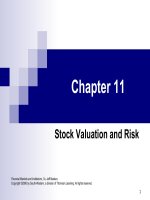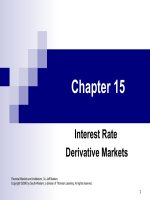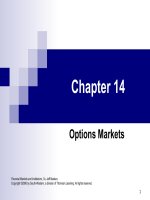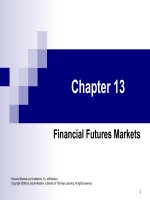Tài liệu Thị trường tài chính và các định chế tài chính_ Chapter 02 doc
Bạn đang xem bản rút gọn của tài liệu. Xem và tải ngay bản đầy đủ của tài liệu tại đây (268.24 KB, 31 trang )
1
Chapter 2
Determination of Interest Rates
Financial Markets and Institutions, 7e, Jeff Madura
Copyright ©2006 by South-Western, a division of Thomson Learning. All rights reserved.
2
Chapter Outline
Loanable funds theory
Economic forces that affect interest rates
Forecasting interest rates
3
Loanable Funds Theory
Loanable funds theory suggests that the
market interest rate is determined by the factors
that affect the supply of and demand for loanable
funds
Can be used to explain movements in the general
level of interest rates of a particular country
Can be used to explain why interest rates among debt
securities of a given country vary
4
Loanable Funds Theory (cont’d)
Household demand for loanable funds
Households demand loanable funds to finance
Housing expenditures
Automobiles
Household items
There is an inverse relationship between the interest rate and
the quantity of loanable funds demanded
5
Loanable Funds Theory (cont’d)
Business demand for loanable funds
Businesses demand loanable funds to invest in fixed assets and
short-term assets
Businesses evaluate projects using net present value (NPV):
Projects with a positive NPV are accepted
There is an inverse relationship between interest rates and
business demand for loanable funds
∑
=
+
+−=
n
t
t
t
k
CF
INVNPV
1
)1(
6
Loanable Funds Theory (cont’d)
Government demand for loanable funds
Governments demand funds when planned expenditures are not
covered by incoming revenues
Municipalities issue municipal bonds
The federal government issues Treasury securities and
federal agency securities
Government demand for loanable funds is interest-inelastic
7
Loanable Funds Theory (cont’d)
Foreign Demand for loanable funds
Foreign demand for U.S. funds is influenced by the interest rate
differential between countries
The quantity of U.S. loanable funds demanded by foreign
governments or firms is inversely related to U.S. interest rates
The foreign demand schedule will shift in response to economic
conditions
8
Loanable Funds Theory (cont’d)
Aggregate demand for loanable funds
The sum of the quantities demanded by the separate sectors at
any given interest rate is the aggregate demand for loanable
funds
9
Loanable Funds Theory (cont’d)
D
h
Household Demand
D
b
Business Demand
10
Loanable Funds Theory (cont’d)
D
g
Federal Government Demand
D
m
Municipal Government Demand
11
Loanable Funds Theory (cont’d)
D
f
Foreign Demand
12
Loanable Funds Theory (cont’d)
D
A
Aggregate Demand
13
Loanable Funds Theory (cont’d)
Supply of loanable funds
Funds are provided to financial markets by
Households (net suppliers of funds)
Government units and businesses (net borrowers of funds)
Suppliers of loanable funds supply more funds at higher interest
rates
14
Loanable Funds Theory (cont’d)
Supply of loanable funds (cont’d)
Foreign households, governments, and corporations
supply funds by purchasing Treasury securities
Foreign households have a high savings rate
The supply is influenced by monetary policy
implemented by the Federal Reserve System
The Fed controls the amount of reserves held by depository
institutions
The supply curve can shift in response to economic
conditions
Households would save more funds during a strong
economy
15
Loanable Funds Theory (cont’d)
S
A
Aggregate Supply
16
Loanable Funds Theory (cont’d)
Equilibrium interest rate - algebraic
The aggregate demand can be written as
The aggregate supply can be written as
fmgbhA
DDDDDD ++++=
fmgbhA
SSSSSS ++++=
17
Loanable Funds Theory (cont’d)
S
A
Equilibrium Interest Rate - Graphic
D
A
i
18
Economic Forces That Affect
Interest Rates
Economic growth
Shifts the demand schedule outward (to the right)
There is no obvious impact on the supply schedule
Supply could increase if income increases as a result of the
expansion
The combined effect is an increase in the equilibrium interest
rate
19
Loanable Funds Theory (cont’d)
S
A
Impact of Economic Expansion
D
A
i
D
A2
i
2
20
Economic Forces That Affect
Interest Rates (cont’d)
Inflation
Shifts the supply schedule inward (to the left)
Households increase consumption now if inflation is
expected to increase
Shifts the demand schedule outward (to the right)
Households and businesses borrow more to purchase
products before prices rise
21
Loanable Funds Theory (cont’d)
S
A
Impact of Expected Increase in Inflation
D
A
i
D
A2
i
2
S
A2
22
Economic Forces That Affect
Interest Rates (cont’d)
Fisher effect
Nominal interest payments compensate savers for:
Reduced purchasing power
A premium for forgoing present consumption
The relationship between interest rates and expected inflation is
often referred to as the Fisher effect
23
Economic Forces That Affect
Interest Rates (cont’d)
Fisher effect (cont’d)
Fisher effect equation:
The difference between the nominal interest rate
and the expected inflation rate is the real
interest rate:
R
iINFEi += )(
)(INFEii
R
−=
24
Economic Forces That Affect
Interest Rates (cont’d)
Money supply
If the Fed increases the money supply, the supply of loanable
funds increases
If inflationary expectations are affected, the demand for
loanable funds may also increase
If the Fed reduces the money supply, the supply of loanable
funds decreases
During 2001, the Fed increased the growth of the money supply
several times
25
Economic Forces That Affect
Interest Rates (cont’d)
Money supply (cont’d)
September 11
Firms cut back on expansion plans
Households cut back on borrowing plans
The demand of loanable funds declined
The weak economy in 2001–2002
Reduced demand for loanable funds
The Fed increased the money supply growth
Interest rates reached very low levels









